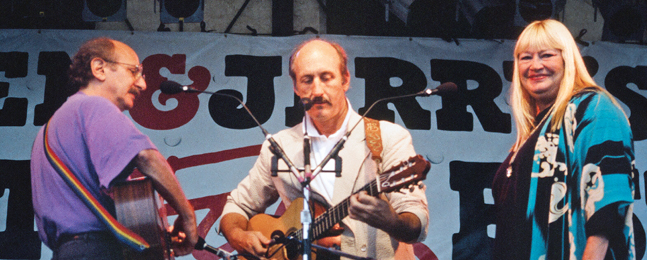Come Gather ’Round, People

Ken Franckling
HOW MANY ROADS: Peter, Paul and Mary in the mid-1990s. The trio debuted at Newport in 1963, as did Bob Dylan, both singing versions of "Blowin' in the Wind."
by Robert Levins
In August 2009, reporter Rick Massimo, MFA’98, was covering the Newport Folk Festival for The Providence Journal. Happily prowling around backstage, he took in the behind-the-scenes bustle, folk star Pete Seeger and several generations of performers singing onstage, and the huge crowd beyond.
“I have to inspire people to feel what I am feeling right now,” Massimo recalls thinking at the time. With the publication of his book “I Got a Song: A History of the Newport Folk Festival” (Wesleyan University Press, 2017) — the first book to tell the festival’s complete story — he does just that.
Along the way, Massimo makes a convincing case for the festival’s musical and historical significance. It introduced Joan Baez to a national audience and showcased the young Bob Dylan. It bolstered the cause of civil rights. “We Shall Overcome” became a civil-rights anthem after Dylan, Baez, Seeger and others sang it to close the 1963 festival, exactly a month before Baez performed it at the March on Washington. Two years later, President Lyndon Johnson invoked the song in a speech to Congress urging the passage of the Voting Rights Act.
Jazz promoter/pianist George Wein staged the first Newport Folk Festival in 1959, five years after co-creating the Newport Jazz Festival. Though some saw him as a businessman first and foremost, Wein had a genuine passion for civil rights, which Massimo details. Promoting a more progressive society was part of both his festivals’ missions, either implicitly (in the case of the jazz festival) or explicitly (the folk festival). Activist groups like the Congress of Racial Equality and the Student Nonviolent Coordinating Committee routinely manned information tables at the folk festival during its early years.
The festival’s musical legacy is a hybrid one. Seeger, a godfather of the folk boom of the ’50s and early ’60s, and an organizer of the Newport Folk Festival from its beginning, was a purist at heart. But he also understood that popular artists would draw crowds. As a result, commercial acts like the Kingston Trio were booked alongside the revivalist ensemble New Lost City Ramblers; roots artists Bill Monroe and Muddy Waters; and emerging singer-songwriters like Dylan, Tom Paxton and Phil Ochs.
“I Got a Song” spotlights lesser-known behind-the-music Newport stalwarts, like talent scouts Ralph Rinzler, Mike Seeger and Tom Hoskins. In the early 1960s, Hoskins went on a hunt for bluesman Mississippi John Hurt, who had vanished into obscurity after releasing 12 sides for Okeh Records in 1928. Hoskins realized Hurt’s recording “Avalon Blues” had to offer a clue to his whereabouts. He went to Avalon, Mississippi; found Hurt right away; and persuaded him to appear at Newport, where he was a highlight of the 1963 festival.
Dylan debuted at Newport that year, too, performing “Masters of War” and “Blowin’ in the Wind,” among other songs. But it was his appearance in 1965, when he plugged in an electric guitar, that really marked the dividing line between old and new. Massimo makes this storied event fresh by quoting a cast of festival participants and observers. The chapter reads like a raucous argument at a family party where, depending on your point of view, something has gone either terribly wrong or thrillingly right.
Partly because of Dylan’s move to rock-and-roll, and the violence and unruly crowds that descended upon the Newport Jazz Festival in 1969, the folk festival was suspended in 1970. It was resurrected 15 years later. Since then, the event has endured through change and more change. Ben & Jerry’s Ice Cream made social activism an essential element of its corporate sponsorship of the festival. Indigo Girls dominated the ’90s shows. In the 2000s, acts with arguably little or no connection to folk, like Brian Wilson and Jimmy Buffett, performed, along with young roots-oriented acts like Old Crow Medicine Show. Wilco, Fleet Foxes and John Prine headlined this year.
Throughout the festival’s history, questions about folk-music authenticity (for instance, can an artist be commercial and authentic) have never been settled. Rather, as Massimo observes, the festival is part of a continuing dialogue. Performers as diverse as Odetta in 1959, the electrified Dylan in 1965 and the radioready Lumineers today make the Newport Folk Festival feel “like one conversation stretched out over a lifetime,” he says.
Folk music has long been an avenue for expression when other avenues are closed off, requiring only a beat-up acoustic guitar. But folk artists can also make music with “a cheap computer or a tablet that has some beats on it,” Massimo says — the use of technology doesn’t mean it’s not folk music.
In reality, says Massimo, folk music relies upon the performer’s and the audience’s attitude. He cites singer-songwriter Dar Williams, who says folk’s defining factor is “an audience that listens.”
This interplay of factors — tradition and innovation, the political and the personal, performer and audience — promises to keep the Newport Folk Festival vital for years to come.
Robert Levins is a writer and musician in Boston.
